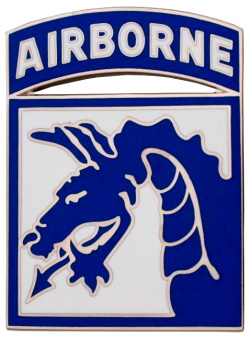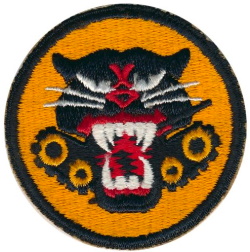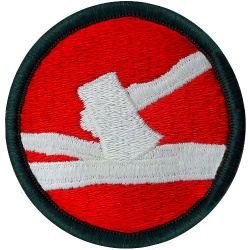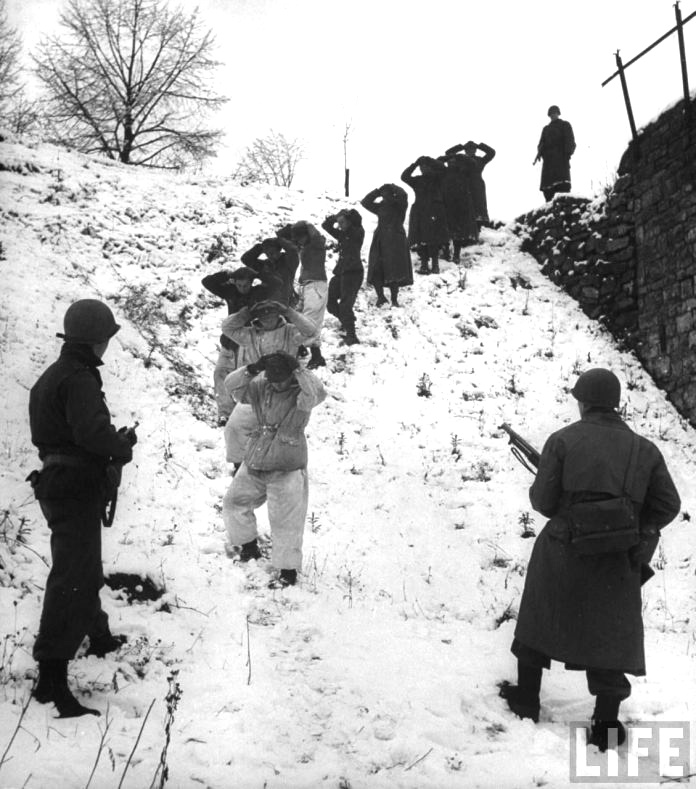Document Source: Operations of the 3rd Battalion, 291st Infantry Regiment, 75th Infantry Division (Maj Gen Gay B. Prickett), North of the town of Aldringen, Belgium in January 1945, during the Battle of the Bulge. Personal Experience of a Battalion Intelligence Officer, Capt Archie R. Hyrle.
This archive covers the operation of the 3rd Battalion of the 291st Infantry Regiment of Gen Gay B. Prickett’s 75th Infantry Division, in the combat approach to Aldringen, Belgium, on January 22, 1945, during the Ardennes Campaign. In order for the reader to have a better understanding of this operation, let us view some of the dominating events directly preceding this campaign. Since June 6, 1944, when the Allies landed on the Normandy Beaches in France, they had been able to push steadily forward, and in the space of approximately six months, stood poised on the Western Border of Germany. At this period, the morale of our troops was high, as the fighting reduced, but the supply lines became long, the weather became severe, and at this particular phase of the war, the counteroffensive of the Germans known as the Battle of the Bulge began.
On the morning of January 3, 1945, we find the allied air forces pounding the German lines of communication, troops, and supply concentrations. At the same time, Patton’s 3-A continued its fighting around Bastogne, in Belgium. Hodges’ 1-A began its offensive from the north, Collins’ VII Corps leading the attack, Ridgway XVIII Corps (Airborne) on the east, and Horrocks’ British XXX Corps on the west. For the next eleven days, Gen Hodges’ 1-A attacking from the north and Gen Patton’s 3-A attacking from the south ground their way steadily forward against a still unbeaten enemy and weather conditions at least as formidable as the enemy. The snow in many cases was two feet deep and practically every move was accompanied by the loss of troops because of frozen hands, feet, or faces. The weather conditions of the 1944-1945 winter in the Belgian Ardennes Forest were the most severe in over sixty years. On January 16, Hodges’ 1-A and Patton’s 3-A joined at Houffalize, Belgium, executed one turns to the left and to the right respectively, and attacked due east. From this time forward in the campaign, most units were confronted with the task of fighting a retreating enemy from one roadblock or ambush to another.
DIVISION AND REGIMENTAL SITUATION

 Before January 15, Prickett’s 75-ID had never fought as an entire division. Now, with all its organic units together for the first time, under the Ridgway’s XVII Airborne Corps, the division was ready for offensive operations, and during the next seven days, it received its baptism of fire as a division. On January 22, the 75-ID Hqs was located in Vielsalm, Belgium, and the division was about to start a new operation. The enemy had hastily but skillfully organized defenses along the
Before January 15, Prickett’s 75-ID had never fought as an entire division. Now, with all its organic units together for the first time, under the Ridgway’s XVII Airborne Corps, the division was ready for offensive operations, and during the next seven days, it received its baptism of fire as a division. On January 22, the 75-ID Hqs was located in Vielsalm, Belgium, and the division was about to start a new operation. The enemy had hastily but skillfully organized defenses along the 
 line, Rogery, Commanster, Hinderhausen, and the division was given the mission of taking the towns of Braunlauf, Maldingen, and Aldringen. The division was deployed generally along the aforementioned German line at a distance of approximately five and one-half miles and planned to move southeast with two regiments abreast. The 290-IR, with elements of the 750-TB attached
line, Rogery, Commanster, Hinderhausen, and the division was given the mission of taking the towns of Braunlauf, Maldingen, and Aldringen. The division was deployed generally along the aforementioned German line at a distance of approximately five and one-half miles and planned to move southeast with two regiments abreast. The 290-IR, with elements of the 750-TB attached  occupied a position on the left flank of the division sector from a point north of Commanster north to the limiting point between the 75-ID and the 30-ID on its left. The 291-IR, with Charlie Co 750-TB, attached, occupied the right half of the division sector from a point north of Commanster to the right limiting point between Prickett’s 75-ID and Bolling’s 84-ID on its right. The 289-IR was held in the division reserve. Hobbs’ 30-ID on the left and the 84-ID on the right were making simultaneous movements in conjunction with the 75-ID.
occupied a position on the left flank of the division sector from a point north of Commanster north to the limiting point between the 75-ID and the 30-ID on its left. The 291-IR, with Charlie Co 750-TB, attached, occupied the right half of the division sector from a point north of Commanster to the right limiting point between Prickett’s 75-ID and Bolling’s 84-ID on its right. The 289-IR was held in the division reserve. Hobbs’ 30-ID on the left and the 84-ID on the right were making simultaneous movements in conjunction with the 75-ID.
The 291-IR occupied a position about 1.5 miles south of Bèche, Belgium, and faced generally southeast. The 1/291-IR, with one platoon of tanks from Charlie Co 750-TB attached, was in line siding with the 3/291-ID with an equal platoon of tanks attached. The regiment planned to move out (when directed) with these two battalions online and the 2/291-IR in reserve. The regimental mission was to secure the ground on this side of Aldringen and Maldingen and ultimately capture the towns. The 1/291-IR was to move out at 0200 on January 22, and seize the small town of Commanster and the high ground to the east, then on to the dominating terrain north of Maldingen. The 3/291-ID was to leave its initial position at 0800 and move southeast to secure the railroad in the vicinity of Aldringen in preparation for attacking the town.
BATTALION SITUATION
The 3/291-IR after having fought in this area for almost a month had lost heavily in personnel. Most of the evacuations of troops resulted from parts of the body being frozen, trench foot, or dysentery. A relatively small percentage was due to actual gun-inflicted wounds, although fighting had been continuous. It was impossible to secure replacements and the men were extremely tired physically. The battalion was relieved from Petit-Thier on January 21 and moved to the rear through Vielsalm and on to the area, 1.5 miles southeast of Bèche to relieve elements of the 289-IR. It left Love Company in Blanche-Fontaine as a holding force as the 1/291-R reorganized. When the 3/291-IR was one company short, the 2/291-IR furnished Fox Company to take its place. Love Company saw no action with the battalion during the period covered by this archive. The battalion closed in the area by 1300, the afternoon of January 21, and the battalion command post was set up in a large farmhouse which was the only shelter in the battalion front line area. Fox Company was on the left and King Company on the right with Item Company in reserve. The two front-line companies occupied the military crests of their respective positions. The battalion aid station, the ammunition, and the pioneer platoon were located in the woods about 1200 yards northwest of the battalion CP. The battalion kitchens were with the regimental train. It was planned to feed a hot meal the evening of the 21 just prior to darkness and a hot breakfast the next morning.
The area to the battalion front was thickly wooded with scattered fire breaks which seemed to run, in most cases, parallel to the front. Except when looking down a fire break, the visibility in the timber was limited to approximately 30 yards. There were a few small clearings throughout the area where timber had been cut, and in these areas, the snow was over 2 feet deep. The snow in the densely timbered areas was only a little over a foot deep as much of the snow was held on the branches of the heavy pine timber. No dominating road of any kind existed in the battalion area of advance, and the fire break trails with snow over 2 feet deep were impassable to the vehicles of the battalion. From the battalion position, neither side could observe the other to any great advantage. The weather had taken a turn for the worse and the temperature had dropped to a few degrees above zero. Everything was frozen solid and the snow which seemed to blanket the entire world made any movement by vehicle or troops very difficult. During the afternoon, recon patrols were sent out from both Fox and King Cos. All patrols returned with negative reports except that King Co’s patrol reported tank movement further south in the direction they thought to be the town of Beho, Belgium. Any previous tracks of German vehicles or troops had been obliterated by the heavy snow. No additional patrols were sent out before the battalion moved out.
Telephone contact with the Regimental S-2 and personal contact with officers of the 289-IR gave very little new information regarding the enemy. The Germans were withdrawing from the area with all possible haste using delaying rear guard action, and their morale was reported as extremely low. Their poorest troops were being used to delay the Americans and the only reason they manned their weapons at all was because of the one or two SS troopers left behind with each detachment to enforce resistance. The Regimental S2 did state that Intelligence Agents had reported from Corps that all Germans had withdrawn to the area of St Vith. At approximately 2100, on the evening of January 21, Maj Bruce B. Bissell, the battalion CO, received orders to report to the regiment for the battalion order. Maj Bissell took Capt Commador Fergeson (S3) and left for the regiment immediately. Maj Bernard S. Handy, the Executive Officer, was instructed to notify all company commanders to stand by. At about 2300, the battalion order was issued – March Objective.
BATTALION PLAN OF ATTACK
The 3/291-IR was given a March Objective which was to sweep the woods to its front by moving southeast a distance of approximately 6 miles and take up positions along the railroad bank in preparation for attacking the town of Aldringen. Since the enemy was reportedly fleeing the area, the battalion expected no resistance. Movement planned to move out at daylight (0800) with Fox and King Cos abreast and Item Co in reserve. Fox Co was to move out in a column formation on a magnetic azimuth of 135 degrees using such trails and fire breaks as available, Fox Co was to secure one portion of the railroad and be prepared to move against Aldringen on order. King Co on the right was to use the same general plan and azimuth and secure the railroad and be prepared to move against Aldringen on order. Item Co was to follow to the left rear of King Co at about 150 yards and maintain contact with the 84-ID on the battalion’s right. Lt James Caskey with his platoon was to keep this contact. Item Co was also to be prepared to relieve or pass through Fox or King Co should a situation so dictate. Contact on the left with the 1/291-IR was to be maintained by Fox Co. Dog Co was to furnish regular forward mortar observers for the rifle companies and be prepared to fire on call. No preparatory fires were planned or fired. One platoon of machine guns was attached to each of the 2 forward companies.
The battalion command group was to follow the right half of Fox Co and the battalion rear command post was to be maintained in the farmhouse until it could be displaced forward to the area of Beho. Artillery and mortar concentrations were plotted over the entire area to the front. All prominent features were plotted and given a numbered concentration; however, none of the numbered concentrations were registered prior because of a lack of observation. No artillery planes were up because of the bad weather and the absence of landing fields. One platoon of tanks was to arrive on the morning of January 22 and proceed with the battalion as soon as a route could be determined. The battalion command group was to lay wire as they moved forward, giving the forward battalion communication with the battalion rear and the regiment. SCR 300 radios were to remain open and this was practically the only means of communication for the companies with the battalion. Messengers could be used but since the terrain was rough and the snow deep, the movement would be very slow. The Artillery Liaison Officer’s radio offered the battalion an alternate contact with the regiment. The battalion ammunition point and aid station were to move forward to the vicinity of the farmhouse just as soon as the battalion moved out. The ammunition supply was to follow behind Fox Co using fire breaks and trails as they were cleared. All individual equipment not needed was to be left behind and brought up on vehicles in the afternoon (bedrolls, etc. ). A small amount of extra ammunition and K rations were issued on the evening of January 21.
THE ATTACK
As 0800 neared on the morning of January 22, all seemed to be in order except that the tanks promised to the battalion had not arrived. This was not a deciding factor at the time because the tanks could not proceed with the battalion until a route was cleared. Item and King Companies were feeding a hot breakfast, but Fox Co encountered difficulty in feeding because of a misunderstanding between its commander, Capt James S. Drake, and the Executive Officer of the 2/291-IR, Maj Paul M. Woods (Statement Capt James S. Drake, CO Fox Company). Some of the troops were forced to move out without food. Fox Co crossed its line of departure at 0800 in a column formation with scouts out in front. King Co reported at 0800 that it, too, was moving southeast. Because of the densely wooded terrain, the battalion commander planned to follow the advancing company as closely as possible to keep in contact at all times.
At 1000, King, Fox, and Item Companies had reported their approximate positions several times. Fox reported that movement was extremely difficult because of the rough terrain. King was somewhat less than 1.5 miles west of Fox and had lost much time in by-passing several deep ravines. Both companies were forced to take numerous halts for the troops to remove snow from equipment and clothing. The snow was so deep on the ground and so thick on the low-hanging pine branches that it was impossible to travel any distance without being covered with snow. The battalion CO directed that all companies would move slowly to conserve the strength of the men.
At 1145, unexpected contact with the enemy was made by Fox at a position where two small trails crossed. Two German riflemen in a dugout were discovered and killed. At about the same time King’s scouts were fired upon from a dugout and one man was wounded. One German was taken prisoner and the other who refused to leave the dugout was killed. The prisoner was sent to the rear by way of battalion forward CP where he verified the report that all forces had withdrawn from the area the previous day. He and his comrade had been left behind for unexplained reasons. He wore an SS Trooper’s uniform but insisted that he was not an SS Trooper. He said he was wearing the coat only because it was warmer than his own and of white camouflage material. Although he looked about fourteen, his sold book stated that he was sixteen. After these encounters, the battalion proceeded with a little more caution.
At 1400, it was obvious that everyone was extremely fatigued. For almost 6 hours the battalion had moved through the deep snow and thick timber and because it had been necessary to lift the knees very high with almost every step, all felt they had traveled at least 6 miles. It was later learned that the battalion had covered only a little more than 3 miles. Much time and distance had been lost by lengthy detours and continuous doubling back for better walking conditions. The battalion CP group caught up with the rear elements of King Co at about 1500 and at this time the wire communication with the battalion rear went out. It was necessary for the battalion forward CP group to drop back, set up the battalion SCR 300 radio with a long antenna, and try to contact the battalion rear. After over 30 minutes the contact was made and it was learned that a repair crew had already started forward checking the telephone lines.

























